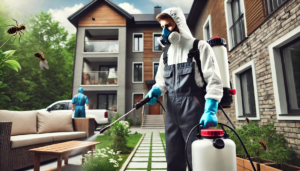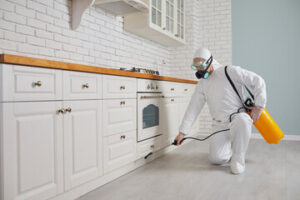Pest Control Simi Valley CA involves deciding when and how to manage pests. Threshold-based decision-making includes scouting and monitoring to determine if the pest numbers are high enough to warrant action.
Control methods include removing food, water, and shelter sources. For example, cleaning up crumbs and regularly removing trash from the property can reduce cockroach and silverfish populations.

Although most pest control methods focus on treatment once an infestation occurs, preventing it is the best way to avoid costly repairs and annoyances. Prevention involves eliminating conditions that attract pests to a property. It requires a consistent effort and a proactive mindset. It includes sealing entry points, maintaining cleanliness, controlling moisture, storing food in sealed containers, and scheduling regular inspections and maintenance. It also means educating yourself about the pests you’re dealing with and the options available for their control.
Preventative pest control is a valuable service for homeowners because pests can damage wood, fabrics, wires, and other items in buildings and structures. They can also carry diseases and allergens that can be harmful to people and pets. In addition, they can cause structural damage and make it unsafe for humans to occupy buildings.
A pest is any organism that causes stress or damage to a desirable plant or crop. The most familiar pests are insects, but weeds and disease-causing pathogens can also be considered pests. Pests can be introduced to crops by wind, water, animals, other plants, or people. Agricultural pests include weeds that compete with crops for resources, disease-causing pathogens, and insects that spread crop diseases.
Some pests are migratory or seasonal, while others are continuous and require regular pest control services. Some pests are sporadic, meaning they appear occasionally or intermittently but can be controlled by sanitation practices. It’s important to understand the factors that influence pest populations, which is why implementing integrated pest management (IPM) strategies is key to successful prevention.
IPM involves combining physical, biological, and chemical controls to manage pests and create an environment that’s unfavorable for them. These approaches can reduce the use of chemicals and help prevent human and environmental harm. Biological controls include the introduction of a pest’s natural enemies, such as parasites, predators, or pathogens. It can also include the release of sterile males or pheromones that deter pests from breeding. Using IPM can also minimize the need for chemical treatments and may even eliminate the need for them altogether. If you do have to resort to treatment, ask your pest control operator about the types of chemicals they’ll be using and how they will be applied. Also, be sure to write down the name and EPA registration number of any chemicals you apply or receive from pest control operators.
Suppression
Suppression is the process of reducing pest numbers to an acceptable level. This can be achieved through cultural controls, physical barriers and biological control. In some cases, suppression may also require the use of chemicals. The choice of tactics to be used for the specific pest is based on the pest biology and behavior, limitations placed on the area where the pest is present, tolerance for damage, economics, and impacts of the control measures themselves.
In outdoor pest situations, eradication is rarely a goal – it is more practical to prevent the pest from causing damage that exceeds a reasonable threshold. This is especially true in the case of disease pests where the presence or threat of the pest can have a significant impact on human health and the economy. However, eradication can be an important goal in enclosed areas where certain pests have no natural enemies (e.g. greenhouses).
Biological control is the use of organisms that naturally attack and/or prey on pest species. This can be accomplished through the importation of the pest’s natural enemies or augmentation with the addition of these organisms to a particular environment. Biological control is more complex than chemical management since the natural enemies are ALIVE and form dynamic populations that must be maintained and fed. Accurate identification of the pest is required to ensure that the correct enemy species is purchased and released. Environmental conditions, particularly temperature and moisture must be appropriate for the success of the organism. Food sources must be available – for example, some parasitoids feed on the leaves of the host plant to sustain themselves.
A more common method of biological control is the augmentation technique, where the natural enemies are purchased or collected from the pest’s habitat and then added to the desired environment in order to increase their population size. Depending on the pest and environment, this may be done through inoculative or inundative releases. In addition, some growers use physical barriers (netting, screens, tillage and mulch) to deprive the pest of a favorable environment. Others provide the predators, parasitoids, and diseases with the habitat they need by growing plants that serve as hosts or shelter for these organisms.
Eradication
In pest control, eradication is the complete removal of all individuals of a species from an area such that recolonization is highly unlikely. This process is very difficult and expensive. It can also have unintended consequences, such as the elimination of native biodiversity and the disruption of human-nature interactions. However, eradication does have its place as part of a comprehensive pest control strategy.
Eradication is a long-term, large-scale effort that requires cooperation and coordination between local and national government agencies, community groups, and property owners. It is not a replacement for preventative and suppression treatments. Eradication efforts must be coordinated and monitored by experienced professionals. Failures can occur due to weather, soil conditions, and host resistance. However, a successful eradication program can benefit both the environment and the economy.
To eradicate an infestation of Deathwatch Beetles in a historic home, it is recommended that the building owner take primary prevention measures such as improving ventilation to reduce humidity levels and simple housekeeping practices to eliminate detritus build up. If the infestation persists, chemical treatment may be needed. However, it is important to remember that this will likely damage the integrity of the fabric of the building and should be considered carefully.
Often pesticide applications fail because the pests are resistant or they have moved into an area where the chemical is not effective. Eradication strategies should include a combination of tools, such as mass trapping and the sterile insect technique (SIT), to achieve better results.
Chemical solutions are easier to find and use and deliver instant results, but they can pose health risks on exposure and cause environmental pollution. Some chemicals are also endocrine disrupters, which may have adverse effects on human health over time. Biological controls, on the other hand, have lower costs and less impact on non-target organisms.
Physical trapping and netting are examples of preventative methods and can be used to catch pests before they cause major structural damage or damage the ground. They are also a way to manage the presence of introduced predators on the property. This approach is very effective for controlling populations of stoats and ferrets, but it has less success with other pests.
Monitoring
Pest monitoring is the process of checking or scouting for pests to determine what kinds of pests are in an area and how many of them are there. This information is critical in determining whether or when to start control tactics. Monitoring can be done using a variety of tools, from simple traps to complex sensor-equipped monitors.
For example, a trap designed to capture aphids may have a cardboard base covered in a sticky, glue-like substance that pests cannot escape from once they land on it. These types of traps are inexpensive, portable and often work 24 hours a day, 365 days a year. Other types of traps use pheromone attractants in combination with a lure to catch pests and can be found at many hardware stores and garden centers.
In some situations, a pest is so dangerous that it requires immediate control. For example, there is usually no tolerance for cockroaches, mice or rats in food plants or hospitals where they can transmit disease to patients and staff. Likewise, pests such as these must be controlled in order to meet environmental standards or regulatory requirements.
Monitoring also helps identify when a pest population is reaching a threshold level where action is required. Threshold levels are established by legal regulations and may be based on economic damage, disease risk or other factors. In agriculture, they can also be influenced by the climate and soil conditions, management practices and pest biology.
Once a pest problem is detected, there are a variety of monitoring tools that can help identify the extent of the problem and guide control strategies. Incorporating monitoring into the overall IPM plan can help to ensure that a strategy is working, provide early warning of problems and enable the development of new strategies if previous ones fail to achieve their intended results.
Many IPM programs also include monitoring for beneficial organisms, which can be used to prevent or reduce the need for chemical controls. These tools are inexpensive, readily available and easy to use, and include pollination diggers for fruit crops, parasitic wasps and entomopathogenic fungi for vegetable production, and ladybugs for turfgrass.
